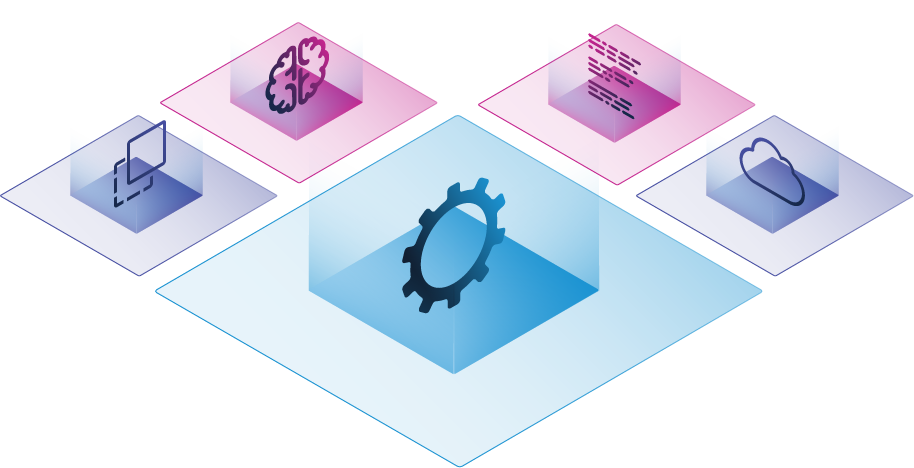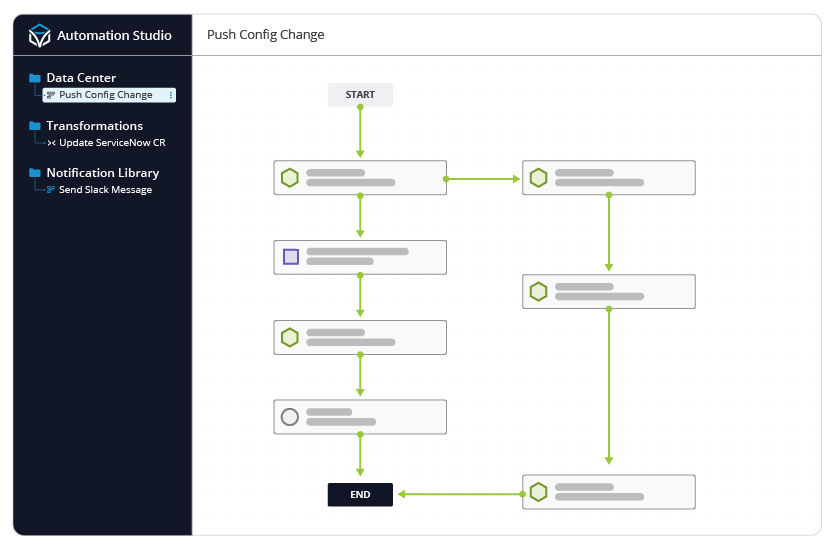Defining Network Automation
The performance and reliability of networks are the critical foundation of today’s enterprise organizations. Automating network management tasks enables network operations teams to ensure agility, flexibility, and effectively support modern business demands.
Network automation describes the approach of using software-based techniques to automate the configuration, orchestration, and management of network resources – whether they are enterprise networks, data center networks, virtual networks, or cloud networks.
Network automation encompasses such functions as:
- Centralized management of the configuration, deployment, and maintenance of network devices.
- Remediating changes before they are made, de-risking vulnerabilities.
- Reducing time spent on repetitive tasks, while also decreasing and eliminating human errors.
- Achieving agility and accurately provisioning of services in real-time.
Why Automate Network Infrastructure?
The performance and reliability of networks have become the foundation of enterprise organizations. The role that networks play in business processes and efficiencies is growing every day, resulting in the increased size and complexity of managing networks. As enterprise networks become more complex and the rate of change increases, network operation teams are forced to deploy multiple tools to obtain visibility and control to manage their network. However, network management has remained largely manual, maintained, and operated by human hands, with tools and techniques such as CLI and scripting. This approach is time intensive and error prone and unable to support the rapidly shifting workload requirements of today’s always on businesses.
Automating network management tasks allows network operations teams to become more agile and flexible and effectively support modern business demands.
What are the Benefits of Network Automation?
Some of the most important benefits of automation are to make networks easier to operate, accelerate the deployment of networking infrastructure and applications, reduce errors and downtime, and optimize its performance. In addition, increasing in the speed at which networking resources are being changed is becoming more crucial than ever as services and trends such as cloud and 5G increase the velocity at which network resources are needed and deployed.
Some of the key advantages of network automation include:
Accelerate Applications Delivery
![]()
Builders of cloud applications and members of DevOps teams need to build networking and security into their software deployments. Network automation can help achieve this goal by integrating with applications.
Network Intelligence
![]()
Artificial intelligence (AI) and Machine Learning (ML) are often employed in automation solutions to collect network data and use model-driven algorithms to learn network behaviors, deliver predictive analysis, and alert network management teams about problems.
Improved Network Planning & Design
![]()
Network automation tools can include planning, testing, and inventory management functions, vastly improving the way new networks are adopted.
Better Testing, Compliance, & Validation
![]()
Using new automation tools and techniques, network configurations can be constantly validated through automated testing. This can reduce network errors and improve network compliance.
Software-Based Management
![]()
Network automation can be used to update and manage software versions and deployments, ensuring a network is always up to date.
How Does Network Automation Work?
Network automation uses software to program how networks are configured, monitored, tested, and operated. In addition, network automation approaches have evolved from the cloud technology world, where infrastructure is often deployed and managed using software.
The building blocks of network automation are industry software standards such as NETCONF YANG, OpenConfig, or Application Programming Interfaces (APIs) provided by original equipment manufacturers (OEMs) and software providers. These software tools enable network automation by providing standardized software models that enable networking hardware to be programmed with code – a movement known as Infrastructure as Code.
By using network automation, network operators can improve the efficiency and reliability of networks, for example, by reducing or even eliminating human error. This simplifies network management across physical, virtual, and cloud infrastructure.
Typical approaches to network automation include:
- Off-the-Shelf Commercial Products
- Open Source Tools (Commercially Supported or Free)
- Internally Developed Software
- One-Off Scripts or Native Device CLI

What are Network Automation Use Cases?
Network automation makes networks more manageable with support for many use cases across any network domain from cloud, IP Services, network applications, branch/SD-WAN, data center, multi-cloud networks, and more.
Some of the top network automation use cases across these domains include:
Why Itential for Network Automation
Itential is the only automation platform built to support both network and cloud, making it easy for enterprise organizations to maintain network compliance, reduce manual operations, and simplify network management. The Itential Automation Platform is a low-code cloud-native SaaS solution that seamlessly connects IT systems with network technologies for end-to-end network configuration, compliance, and automation.

Configuration Management
Ensure your network is secure and reliable by combining automation and compliance. Itential’s Configuration Manager enables configuration standardization across both physical and cloud networks, and CLI and API services.
Rapid, Low-Code Automation
Start fast and stay fast with Itential’s Pre-Built Automations for simple, reusable, and rapid deployment of network automation capabilities. Easily build your own automations using Itential’s low-code, drag-and-drop Automation Studio and publish to other teams through our self-service catalog.
Orchestrate Across Multi-Domain Networks
Simplify network management across physical, virtual, and cloud infrastructure. The Itential Automation Platform makes complicated networks more manageable with support for any use case across any network domain from Cloud, IP Services, Network Applications, Branch/SD-WAN, Data Center, Multi-Cloud, and more.
Additional Resources
Blog: What’s the Difference Between Network Automation & Network Orchestration? Customer Stories: Leading Digital Payments Organization Eliminates Manual Change Processes Across Multi-Domain Networks through Self-Service Automation with Itential Blog: 3 Significant Shifts for Network Automation & Orchestration in 2024 Blog: Dispelling 3 Common Network Automation Myths Video: Evolving the Network Automation Journey from Python to Platforms @ NAF AutoCon0 Podcast: Packet Pushers: Evolving from Python to Platforms for Network AutomationGet Started with Itential
Start a 30 day free trial, or contact us to discuss your goals and how we can help.

